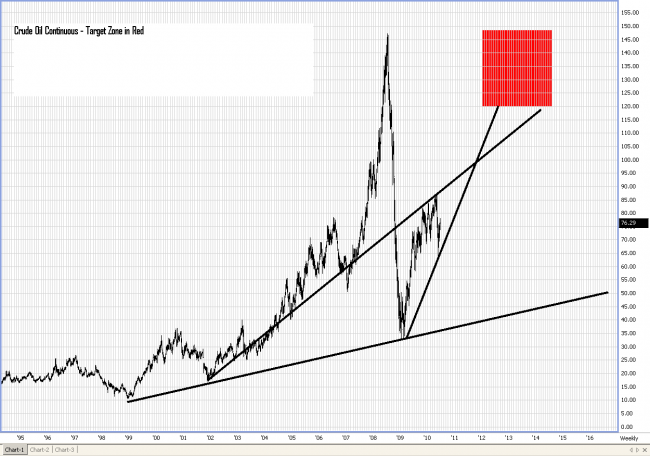Many investors are worried that the Eurozone debt crisis could cause economic slowdowns even in countries outside the region. However, I remain long-term bullish on the prospects for crude oil, as emerging countries continue to experience growth, and we are still many years away from a viable energy alternative. If you agree, you might consider a long-term options strategy that will allow you to weather some short-term price fluctuations in crude oil.
The big question for investors is whether the European economies in trouble right now will take down the global markets, or whether emerging-growth economies will provide enough confidence to stabilize the markets while the debt-ridden countries try and fix themselves.
Growing economies have a growing need for fuel. China’s GDP expanded at 11.9 percent in the first quarter of 2010, industrial production surged 16.5 percent in April, and exports climbed 48.5 percent in May. India’s GDP came in at 8.6 percent in the first quarter, and in April, factory output growth in India neared a 16-year high. It’s not just the Asian economies experiencing growth either—Brazil’s first quarter GDP grew 9 percent. That isn’t to say there won’t be contractions, but the trend overall looks strong.
Even though the BP oil spill in the Gulf has caused many to clamor for cleaner energy, I think demand for oil should remain strong in the long-term. Even in developed economies, a viable alternative could be decades away.
The Gulf oil spill continues to hemorrhage tens of thousands of barrels of oil per day. The majority of U.S. offshore oil reserves come from the Gulf of Mexico, and new offshore drilling seems to be completely shut-down right now. It will be an even more complicated and costly process to come into the market and start exploring because of the disaster. New discoveries could be a thing of the past, and existing platforms are going to see greater surveillance, resulting in higher costs. In the long run, it’s the consumer that will bear those costs. I think the problems in the Gulf will continue to impact the price of oil beyond just the amount lost from this particular well.
When demand increases for oil, so do geopolitical risks as we move to foreign sources, particularly in the Middle East and Venezuela. I don’t see our dependence on foreign oil decreasing dramatically any time soon. One strategy I’ve been recommending right now to clients is a long-term crude oil options spread, as outlined.
Buy the December 2014 crude oil 120 call
Sell the December 2014 crude oil 150 call
These contracts expire on December 31, 2014.
Cost approximately $3,700 not including commissions. (Price subject to change.)
If crude oil is trading above $150 a barrel at expiration, the maximum profit potential on this trade is $30,000 – $3,700 paid = $26,300 (not including commission costs).
The breakeven point occurs when crude oil is priced above $123.70 ($3.70 + $120 plus your commissions)
This is a very long-term trade, but that doesn’t you don’t have to hold it until 2014. You can trade out of this position before that date and take your profit or loss. Your maximum risk is that the spread expires worthless, and then you are out $3,700 plus your commission costs. This is a highly speculative type of trade based on the belief that crude oil demand will remain strong over the next 10 years. That doesn’t mean it will always move straight up, but an options trade such as this one allows you to ride out some market volatility.
Looking at a weekly continuous chart of crude oil, you can see how the price oil started taking off in 1999, although it got crushed in 2008 during the global economic downturn. For the strategy I have outlined to be successful, you want the market to trade in the area represented by the square toward the top right of the chart. The line running along the very bottom represents support.

Feel free to contact me with any questions you have about the markets, and to develop a customized trading strategy based on your unique goals and risk tolerance.
Phil Streible is a Senior Market Strategist with Lind-Waldock. He can be reached at 800-803-8037 or via email pstreible@lind-waldock.com.
Futures trading involves substantial risk of loss and is not suitable for all investors.
Past performance is not necessarily indicative of future trading results. Trading advice is based on information taken from trade and statistical services and other sources which Lind-Waldock believes are reliable. We do not guarantee that such information is accurate or complete and it should not be relied upon as such. Trading advice reflects our good faith judgment at a specific time and is subject to change without notice. There is no guarantee that the advice we give will result in profitable trades. All trading decisions will be made by the account holder.
© 2010 MF Global Holdings Ltd. All Rights Reserved.



